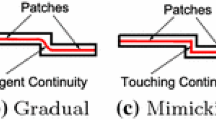Abstract
Shape idealization transformations are very common operations when adapting a CAD component to FEA requirements. Here, an idealization approach is proposed that is based on generative shape processes used to decompose an initial B-Rep solid, i.e., extrusion processes with material addition are used to segment a solid. The corresponding extrusion primitives form the basis of candidate sub-domains for idealization and their connections conveyed through the generative processes they belong to, bringing robustness to set up the appropriate connections between idealized sub-domains. This is made possible because the connections between extrusion primitives have an explicit geometric representation and can be used to bound the connections between idealized sub-domains. Taking advantage of an existing construction tree as available in a CAD software does not help much because it may be complicated to use it for idealization processes because this tree structure is not unique. Using generative processes attached to an object that is no longer reduced to a single construction tree but to a graph containing all non-trivial construction trees, is more useful for the engineer to evaluate variants of idealization. From this automated decomposition, each primitive is subjected to a morphological analysis to define whether it can idealized or not. Subsequently, geometric interfaces between primitives form also a graph that can be used to process the connections between the idealized sub-domains generated from the primitives. These interfaces are taken into account to determine more precisely the idealizable sub-domains and their contours when primitives are incrementally merged to come back to produce the global morphological analysis of the initial object. A user-defined threshold is used to tune the morphological analysis with respect to further user parameters. Finally, the idealizable sub-domains and their connections are processed to locate the mid-surfaces and connect them using generic criteria that the user can tune locally using complementary criteria.














Similar content being viewed by others
References
Boussuge F, Léon JC, Hahmann S, Fine L (2014) Extraction of generative processes from B-Rep shapes and application to idealization transformations. CAD 46:79–89
Buchele SF, Crawford RH (2004) Three-dimensional halfspace constructive solid geometry tree construction from implicit boundary representations. CAD 36:1063–1073
Chong CS, Kumar AS, Lee KH (2004) Automatic solid decomposition and reduction for non-manifold geometric model generation. CAD 36(13):1357–1369
Gao S, Zhao W, Lin H, Yang F, Chen X (2010) Feature suppression based cad mesh model simplification. CAD 42(12):1178–1188
Han J, Pratt M, Regli WC (2000) Manufacturing feature recognition from solid models: a status report. IEEE Trans Robot Autom 16:782–796
Joshi S, Chang TC (1988) Graph-based heuristics for recognition of machined features from a 3d solid model. CAD 20(2):58–66
Kim S, Lee K, Hong T, Kim M, Jung M, Song Y (2005) An integrated approach to realize multi-resolution of b-rep model. In: Proceedings of the 2005 ACM symposium on solid and physical modeling, SPM ’05, pp 153–162
Lee KY, Armstrong CG, Price MA, Lamont JH (2005) A small feature suppression/unsuppression system for preparing b-rep models for analysis. In: Proceedings of the 2005 ACM symposium on solid and physical modeling, SPM ’05, pp 113–124
Leyton M (2001) A generative theory of shape. Lecture notes in computer science LNCS 2145. Springer, Berlin
Li K, Foucault G, Léon J-C., Trlin M (2014) Fast global and partial reflective symmetry analyses using boundary surfaces of mechanical components. CAD 53:70–89, ISSN 0010-4485. doi:10.1016/j.cad.2014.03.005
Li M, Langbein FC, Martin RR (2006) Constructing regularity feature trees for solid models. In: Proceedings of geometric modeling and processing; LNCS, pp 267–286
Lim T, Medellin H, Torres-Sanchez C, Corney JR, Ritchie JM, Davies JBC (2005) Edge-based identification of dp-features on free-form solids. IEEE Trans PAMI 27(6):851–860
Liu SS, Gadh R (1997) Automatic hexahedral mesh generation by recursive convex and swept volume decomposition. In: 6th international meshing roundtable, Sandia National Laboratories, pp 217–231
Lu Y, Gadh R, Tautges TJ (2001) Feature based hex meshing methodology: feature recognition and volume decomposition. CAD 33(3):221–232
Makem JE, Armstrong CG, Robinson TT (2012) Automatic decomposition and efficient semi-structured meshing of complex solids. In: Proceedings of the 20th international meshing roundtable, pp 199–215
Mäntylä M (1988) An introduction to solid modeling. Computer Science Press, College Park
Rezayat M (1996) Midsurface abstraction from 3d solid models: general theory and applications. CAD 28(1):905–915
Robinson TT, Armstrong C, Fairey R (2011) Automated mixed dimensional modelling from 2d and 3d cad models. Finite Elem Anal Des 47(2):151–165
Robinson TT, Armstrong CG, McSparron G, Quenardel A, Ou H, McKeag RM (2006) Automated mixed dimensional modelling for the finite element analysis of swept and revolved cad features. In: Proceedings of the 2006 ACM symposium on solid and physical modeling, SPM ’06, pp 117–128
Seo J, Song Y, Kim S, Lee K, Choi Y, Chae S (2005) Wrap-around operation for multi-resolution CAD model. CAD Appl 2(1–4):67–76
Shapiro V, Vossler DL (1993) Separation for boundary to CSG conversion. ACM Trans Graph 12(1):35–55
Sheen DP, Son TG, Myung DK, Ryu C, Lee SH, Lee K, Yeo TJ (2010) Transformation of a thin-walled solid model into a surface model via solid deflation. CAD 42(8):720–730
Venkataraman S, Sohoni M, Rajadhyaksha R (2002) Removal of blends from boundary representation models. In: Proceedings of the seventh ACM symposium on solid modeling and applications, SMA ’02, pp 83–94
Woo Y (2014) Abstraction of mid-surfaces from solid models of thin-walled parts: a divide-and-conquer approach. CAD 47:1–11
Zhu H, Menq CH (2002) B-rep model simplification by automatic fillet/round suppressing for efficient automatic feature recognition. CAD 34(2):109–123
Acknowledgments
This work is carried out in the framework of the ANR project ROMMA (RObust Mechanical Models for Assemblies) referenced ANR-09-COSI-012 and the authors thank the ANR for its financial support.
Author information
Authors and Affiliations
Corresponding author
Rights and permissions
About this article
Cite this article
Boussuge, F., Léon, JC., Hahmann, S. et al. Idealized models for FEA derived from generative modeling processes based on extrusion primitives. Engineering with Computers 31, 513–527 (2015). https://doi.org/10.1007/s00366-014-0382-x
Received:
Accepted:
Published:
Issue Date:
DOI: https://doi.org/10.1007/s00366-014-0382-x




